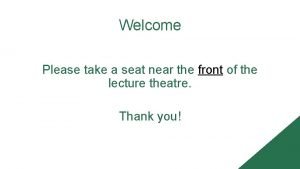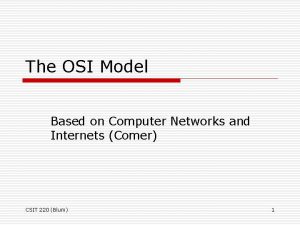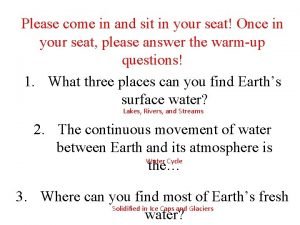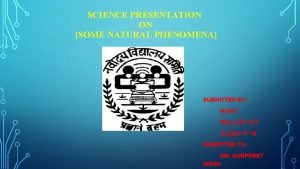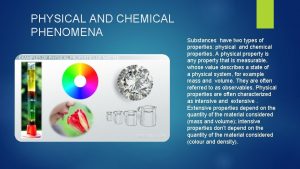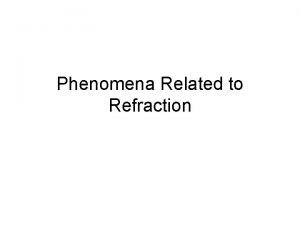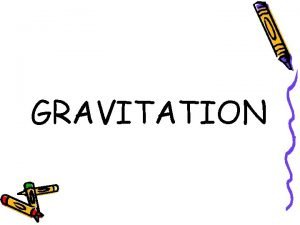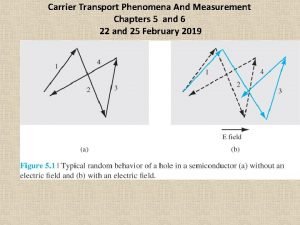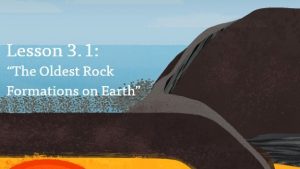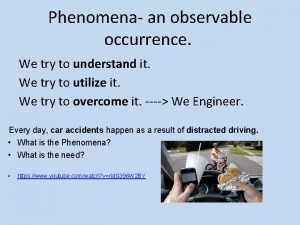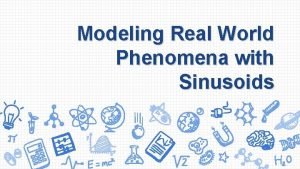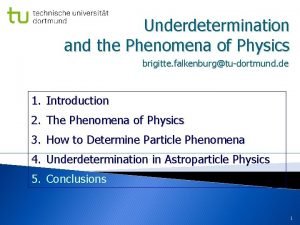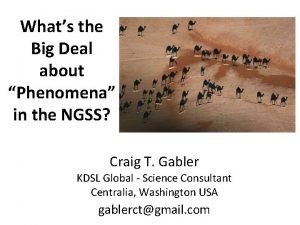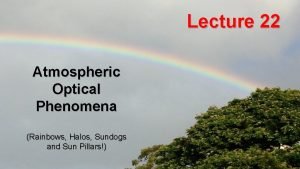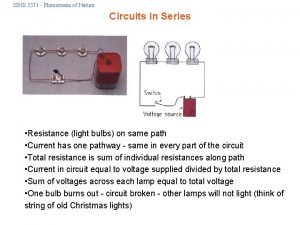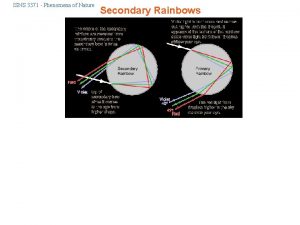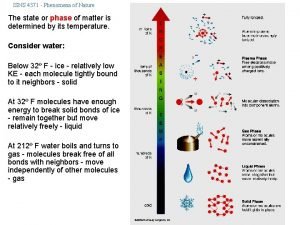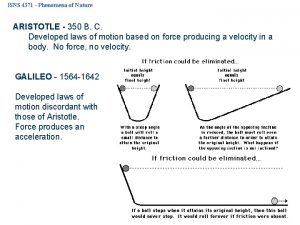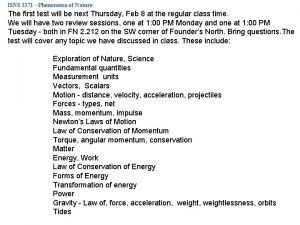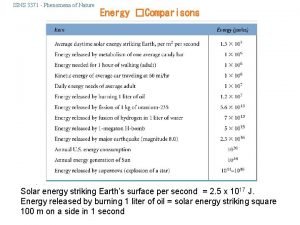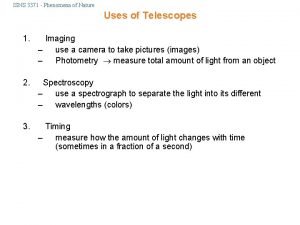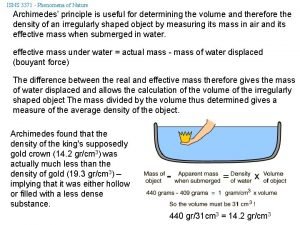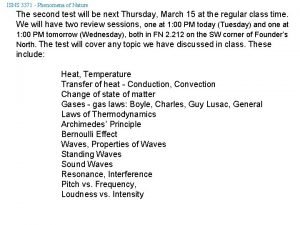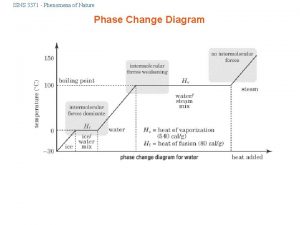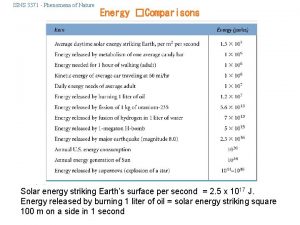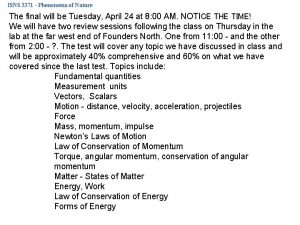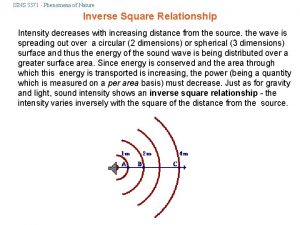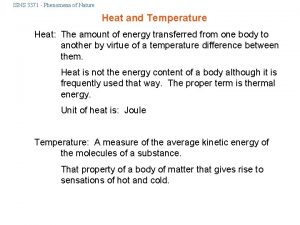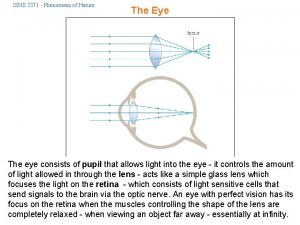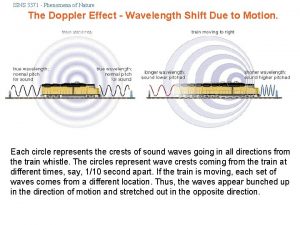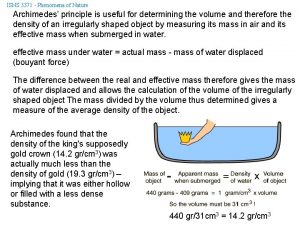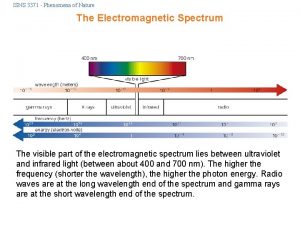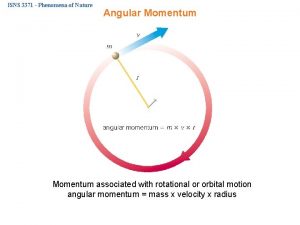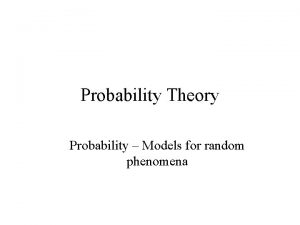ISNS 4371 Phenomena of Nature Please take your




































- Slides: 36

ISNS 4371 - Phenomena of Nature Please take your seat in row 3 - 10. This will be your assigned seat where you will sit throughout the semester. Role will be taken based on this seating.

ISNS 4371 - Phenomena of Nature Hallmarks of Science • Modern science seeks explanations for observed phenomena that rely solely on natural causes. • Science progresses through the creation and testing of models of nature that explain the observations as simply as possible. • A scientific model must make testable predictions about natural phenomena that would force us to revise or abandon the model if the predictions do not agree with observations. The hypotheses we accept ought to explain phenomena which we have observed. But they ought to do more than this: our hypotheses ought to foretell phenomena which have not yet been observed. William Whewell (1794 -1866) English mathematician, philosopher.

ISNS 4371 - Phenomena of Nature Occam’s Razor The idea that scientists should prefer the simpler of two models that agree equally well with observations - the second hallmark - after medieval scholar William of Occam (1285 - 1349). For instance, original model of Copernicus (Sun-centered) did not match the data noticeably better than Ptolemy's model (Earth-centered). Thus, a purely data-driven judgment based on the third hallmark might have led scientists to immediately reject the Sun-centered idea. Instead, many scientists found elements of the Copernican model appealing, such as the simplicity of its explanation for apparent retrograde motion. Was kept alive until Kepler found a way to make it work.

ISNS 4371 - Phenomena of Nature Galileo Galilei (1564 – 1642) I do no feel obliged to believe that the same God who endowed us with sense, reason, and intellect intended us to forgo their use. I have never met a man so ignorant that I couldn’t learn something from him. All truths are easy to understand once they are discovered, the point is to discover them.

ISNS 4371 - Phenomena of Nature Albert Einstein (1879 -1955) When you are courting a nice girl an hour seems like a second. When you sit on a red-hot cinder a second seems like an hour. That's relativity. If my theory of relativity is proven correct, Germany will claim me as a German and France will declare that I am a citizen of the world. Should my theory prove untrue, France will say that I am a German and Germany will declare that I am a Jew. If we knew what it was we were doing, it would not be called research, would it? The most incomprehensible thing about our universe is that it can be comprehended. I shall never believe that God plays dice with the world (speaking about quantum mechanics). A little knowledge is a dangerous thing. So is a lot.

ISNS 4371 - Phenomena of Nature "The airplane stays up because it doesn't have the time to fall. " Orville Wright. "Physics is like sex: sure, it may give some practical results, but that's not why we do it. ” Richard Feynman. The most exciting phrase to hear in science, the one that heralds new discoveries, is not 'Eureka!' ('I found it!') but rather 'hmm. . that's funny. . . '" Isaac Asimov. Examples of “hmmm… that’s funny”: Discovery of penicillin by Alexander Fleming in 1929. Discovery of X-rays by Wilhelm Röntgen in 1895.

ISNS 4371 - Phenomena of Nature FUNDAMENTAL QUANTITIES QUANTITY UNIT DEFINITION Length Meter Mass Kilogram =1000 grams 1 gram = mass of 1 cubic centimeter of water at 4 C. Time Second Time for a cesium atom to make 9, 192, 631, 770 vibrations Force Newton Force to accelerate 1 kilogram by 1 meter per second Energy Joule Amount of work done by a force of 1 Newton acting over a distance of 1 meter Temperature Kelvin 1/273 of temperature of freezing point of water Length of the path traveled by light in a vacuum during 1/299, 792, 458 second

ISNS 4371 - Phenomena of Nature FUNDAMENTAL QUANTITIES QUANTITY UNIT DEFINITION Length Meter Mass Kilogram =1000 grams 1 gram = mass of 1 cubic centimeter of water at 4 C. Time Second Time for a cesium atom to make 9, 192, 631, 770 vibrations Force Newton Force to accelerate 1 kilogram by 1 meter per second Energy Joule Amount of work done by a force of 1 Newton acting over a distance of 1 meter Temperature Kelvin 1/273 of temperature of freezing point of water Length of the path traveled by light in a vacuum during 1/299, 792, 458 second

ISNS 4371 - Phenomena of Nature MEASUREMENT SYSTEMS ENGLISH Developed in England – Used in the United States METRIC Developed after the French Revolution (1791) INTERNATIONAL (SI) The modern version of the metric system - formally established in 1960 by the International Conference on Weights and Measures

ISNS 4371 - Phenomena of Nature EXPONENTIAL NOTATION 1, 000, 000 109 giga G 1, 000 106 mega M 1, 000 103 kilo k 100 102 hecto h 10 101 deka da 1 100 - - 0. 1 10 -1 deci d 0. 01 10 -2 centi c 0. 001 10 -3 milli m 0. 000001 10 -6 micro 0. 00001 10 -9 nano n

ISNS 4371 - Phenomena of Nature SCALES OF DISTANCE Astronomical AU Average distance between the Earth and the Sun Unit Light Year LY Distance light travels in one Year 1 LY = 186, 000 Miles/Second x 31, 500, 000 Seconds = 5. 8 x 1012 Miles Parsec PC Distance of an object that would have a stellar parallax of 1 Second of Arc 1 PC = 3. 26 LY = 206, 000 AU Angstrom A Nanometer nm A distance of 10 -9 meter or 10 -7 cm Visible light has wavelengths from 400 to 700 nm A distance of 1 x 10 -8 cm Visible Light has wavelengths from 4000 to 7000 A

ISNS 4371 - Phenomena of Nature DEFINITIONS Scalar A quantity that has only size or magnitude. Examples: mass, inertia, weight, temperature Vector A quantity that has both size and direction. Examples: velocity, acceleration, force

ISNS 4371 - Phenomena of Nature Some Simple Trigonometry B a C c b c 2 = a 2 + b 2 cos A = b/c sin A = a/c A

ISNS 4371 - Phenomena of Nature Speed, Velocity, and Acceleration Speed - rate of travel - distance per unit time Velocity - speed of travel in a certain direction - a vector - has magnitude and direction Acceleration - rate of change of velocity - change in velocity per unit time

ISNS 4371 - Phenomena of Nature Speed, Velocity, and Acceleration Speed - rate of travel - distance per unit time Velocity - speed of travel in a certain direction - a vector - has magnitude and direction Acceleration - rate of change of velocity - change in velocity per unit time

ISNS 4371 - Phenomena of Nature DEFINITIONS • VELOCITY: Distance per unit time – velocity = distance/time (v=d/t) – A car leaves Dallas at 1: 00 PM and arrives in Austin (200 miles) at 5: 00 PM – average velocity = 200 miles/4 hours = 50 miles/hr – What is the instantaneous velocity at 3: 00 PM? • ACCELERATION: Change in velocity per unit time – velocity = acceleration X time (v=at) – distance = 1/2 acceleration X time squared (d=1/2 at 2) – A car accelerates at 5 miles/s 2 in a straight line – How fast is it going after 4 seconds? 8 seconds – How far has it traveled in 4 seconds? 8 seconds?

ISNS 4371 - Phenomena of Nature DEFINITIONS (CONTINUED) FORCE: Push or pull on a body Mechanical force: Contact between bodies Electrostatic force: Due to electric charges Magnetic force: Due to magnetic poles Gravitational force: Due to mass of a body

ISNS 4371 - Phenomena of Nature Force A force is a push or pull on a body. It is a vector quantity. Net force: The sum of all forces acting on a body. A net force acting on a body causes the body to accelerate, to undergo a change in its velocity. Aristotle’s view: A net force causes a body to have a velocity. Newton’s view: A net force causes a body to experience a in its velocity. change The unit of force in the newton. 1 newton force gives a 1 kilogram mass an acceleration of 1 meter/ second squared. 1 N=1 Kg m/s 2

ISNS 4371 - Phenomena of Nature Equilibrium No net force - sum of all forces equals zero - mechanical equilibrium B a c A C b cos A = b/c sin A = a/c Vector addition - sum of all vertical components equals zero and sum of all horizontal components equals zero - remember simple trigonometry: W 1 X b 1/c 1 = W 2 X b 2/c 2 Horizontal Components W 1 X a 1/c 1 + W 2 X a 2/c 2 = W Vertical Components

ISNS 4371 - Phenomena of Nature Equilibrium No net force - sum of all forces equals zero - mechanical equilibrium B a c A C b cos A = b/c sin A = a/c Vector addition - sum of all vertical components equals zero and sum of all horizontal components equals zero - remember simple trigonometry: W 1 X b 1/c 1 = W 2 X b 2/c 2 Horizontal Components W 1 X a 1/c 1 + W 2 X a 2/c 2 = W Vertical Components

ISNS 4371 - Phenomena of Nature A 1 B a A 2 c C b A cos A = b/c sin A = a/c Example W 1 = 400 gm, W 2 = 300 gm, W = 500 gm a 1=6, b 1=8, c 1=10, a 2=8, b 2=6, c 2=10 Horizontal component of F 1 = W 1 sin. A 1 = W 1(a 1/c 1) Horizontal component of F 2 = W 2 sin. A 2 = W 2(a 2/c 2) W 1(b 1/c 1) = W 2(b 2/c 2) 400 (6/10) = 300(8/10) = 2400/10 = 240 Vertical component of F 1 = W 1 cos. A 1 = W 1(b 1/c 1 Vertical component of F 2 = W 2 cos. A 2 = W 2(b 2/c 1) W 1(a 1/c 1) + W 2(a 2/c 2) = W 400(8/10) + 300(6/10) = 320 + 180 = 500

ISNS 4371 - Phenomena of Nature ARISTOTLE - 350 B. C. Developed laws of motion based on force producing a velocity in a body. No force, no velocity. GALILEO - 1564 -1642 Developed laws of motion discordant with those of Aristotle. Force produces an acceleration.

ISNS 4371 - Phenomena of Nature A New View of Nature Sir Isaac Newton (1642 - 1727) - followed Galileo’s lead - developed fundamental laws of motion - revolutionized mathematics and science - experienced moment of inspiration at 24 years old - saw apple fall from tree and suddenly understood gravity - published most famous book in science in 1687 - Philosophiae Naturalis Principia Mathematica - Principia for short - built first reflecting telescope - invented calculus

ISNS 4371 - Phenomena of Nature DEFINITIONS (CONTINUED) INERTIA: Resistance a body offers to a change in its state of motion. MASS: A measure of a body's inertia MOMENTUM: Mass x velocity

ISNS 4371 - Phenomena of Nature Newton’s First Law A body remains at rest or moves along a straight line with constant velocity so long as no external force acts upon it. I. e. , things tend to keep on what they are already doing. Also called the law of inertia.

ISNS 4371 - Phenomena of Nature Examples: Pulling a table cloth out from under a table setting The reaction of coffee in a cup when accelerating or decelerating in a car Tightening of a hammerhead by banging hammer on the ground Getting ketchup out of a bottle Not wearing a seatbelt during a headon car crash Headrests in a car to prevent whiplash during a read-end collision

ISNS 4371 - Phenomena of Nature Galileo demonstrated that all objects accelerated at same rate regardless of mass - supposedly dropped balls of different mass from Leaning Tower of Pisa Gravity and Acceleration Animation

ISNS 4371 - Phenomena of Nature Acceleration of Gravity All objects in a gravitational field fall at a constant acceleration - g regardless of mass On Earth - g = 9. 8 m/s 2 or 32 ft/s 2 On the Moon - g = 1. 63 m/s 2 or 1/6 th that of Earth Remember: distance = 1/2 at 2 So, to calculate height of building drop a rock and time its fall - h = 1/2 gt 2

ISNS 4371 - Phenomena of Nature Hammer and Feather on the Moon

ISNS 4371 - Phenomena of Nature The Pendulum can be used to calculate g P = 2 (L/g)1/2 P is the period and L is the length of the pendulum g = 4 2 L/P 2 This formula will be derived later when we discuss conservation of energy

ISNS 4371 - Phenomena of Nature Newton’s Second law A body (m) acted upon by a force (f) will accelerate (a) in the direction of the applied force. The greater the force or the smaller the mass, the greater will be the acceleration. F = ma

ISNS 4371 - Phenomena of Nature Newton’s 2 nd Law F = ma or a = F/m Pushing Cart Animation

ISNS 4371 - Phenomena of Nature Mass and Weight • INERTIA: Resistance a body offers to a change in its state of motion. • MASS: A measure of a body's inertia - mass resists acceleration A = F/m Acceleration is inversely proportional to mass • WEIGHT: Gravitational force on a body— Proportional to its mass. Mass is not weight! Weight is as force - the force of gravity. W = F = ma = mg 1 lb = 4. 44 N

ISNS 4371 - Phenomena of Nature 1 kg on the Earth weighs 9. 8 N or 2. 2 lbs F = W = mg W = 1 kg X 9. 8 m/s = 9. 8 kg m/s = 9. 8 N Newton’s 2 nd Law Explains the Feather and the Ball Take a 1 kg rock and a 10 kg rock and drop them from the same height a 1 = F 1/m 1 = W 1/m 1 = 9. 8 N/1 kg = 9. 8 m/s = g a 2 = F 2/m 2 = W 2/m 2 = 98 N/10 kg = 9. 8 m/s = g

ISNS 4371 - Phenomena of Nature Apparent Weight apparent weight - weight force that we actually sense not the downward force of gravity, but the normal (upward) force exerted by the surface we stand on - opposes gravity and prevents us falling to the center of the Earth - what is measured by a weighing scale. For a body supported in a stationary position, normal force exactly balances earth's gravitational force - apparent weight has the same magnitude as actual weight. If no contact with any surface to provide such an opposing force - no sensation of weight (no apparent weight). - free-fall - experienced by sky-divers and astronauts in orbit who feel "weightless" even though their bodies are still subject to the force of gravity - also known as microgravity. A degree of reduction of apparent weight occurs, for example, in elevators. In an elevator, a spring scale will register a decrease in a person's (apparent) weight as the elevator starts to accelerate downwards. This is because the opposing force of the elevator's floor decreases as it accelerates away underneath one's feet.

ISNS 4371 - Phenomena of Nature Apparent Weight Animation
 Isns masjid
Isns masjid Will you please be quiet please summary
Will you please be quiet please summary Slam poetry rubric
Slam poetry rubric Welcome please take a seat
Welcome please take a seat Please do not take sausage pizza away
Please do not take sausage pizza away Sit in your seat
Sit in your seat Please take a seat
Please take a seat Take prepositional phrase
Take prepositional phrase Please take out some time
Please take out some time Please take notes
Please take notes Take a bus or take a train
Take a bus or take a train An aircraft monikko
An aircraft monikko Some natural phenomena ppt
Some natural phenomena ppt Physical and chemical phenomena
Physical and chemical phenomena Refraction phenomena
Refraction phenomena Observable phenomenon
Observable phenomenon Contemporary phenomenon examples
Contemporary phenomenon examples Natural language processing
Natural language processing Reference phenomena in nlp
Reference phenomena in nlp Examples of colloids
Examples of colloids Gravitation is a natural phenomenon where:
Gravitation is a natural phenomenon where: Carrier transport phenomena
Carrier transport phenomena Anchor phenomena
Anchor phenomena Observable phenomena meaning
Observable phenomena meaning Surface and interfacial phenomena
Surface and interfacial phenomena Reoulox phenomena
Reoulox phenomena Global climate phenomena
Global climate phenomena Random phenomena
Random phenomena Noumenal
Noumenal Modeling real world data with sinusoidal functions
Modeling real world data with sinusoidal functions What is the meaning of phenomena
What is the meaning of phenomena Https://slidetodoc.com/
Https://slidetodoc.com/ Hypnotic phenomena
Hypnotic phenomena Noumena vs phenomena
Noumena vs phenomena Critical angle and total internal reflection
Critical angle and total internal reflection A rainbow is an optical display
A rainbow is an optical display Noumena vs phenomena
Noumena vs phenomena



